Mastering the Sicilian Najdorf a review
In the past we had two of the greatest players of all times using the Najdorf as main weapon. And I'm sure everyone knows who I'm referring to...who are the names of today's players playing it? I find the answer to such question fundamental, because often we miss the idea, and the importance, of a role model. Pelletier in the introductory video mentions: MVL, Vishy Anand, Boris Gelfand.
The main tabiya arises after the moves 1. e4 c5 2. ♘f3 d6 3. d4 cxd4 4. ♘xd4 ♞f6 5. ♘c3 a6:
As appetizer I generally go to see some games of the above mentioned players to see how they fare. Obviously it's impossible to really show games of these champions without committing a sin of omission, because they played so many games, against so many top players, with both colors, with different time controls, and of course different periods of their professional lives. But here's what I found:
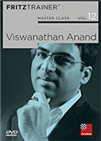 This DVD allows you to learn from the example of one of the best players in the history of chess and from the explanations of the authors how to successfully organise your games strategically, and how to keep your opponent permanently under pressure.
This DVD allows you to learn from the example of one of the best players in the history of chess and from the explanations of the authors how to successfully organise your games strategically, and how to keep your opponent permanently under pressure.It's important to let the reader know this FritzTrainer is only about the Najdorf, with the beginning position the one shown above. This video series will not treat Sicilian sidelines or those typical responses to the Sicilian quite loved at club level like the Alapin, Smith-Morra, Grand Prix etc. One will need another series to prepare for those. Let's hope Pelletier will consider making one, since he's quite good at presenting the topic in a basic way, especially for players who don't know anything about it. For those who cannot wait, GM Daniel King made one few years ago.
I also feel one should have a disclaimer on every type of FritzTrainer where the Sicilian is involved with something like: "If you are older than 15, try this at your own risk!"
With that said, because I care about my readers, I also feel everyone should try something crazy in life, especially when our knees or legs are not involved since we'll need them for our old age! Obviously I consider the Sicilian a vast ocean in which one could lose endless hours without ever being able to play it.
Pelletier also explains the direction the repertoire is going, and it is based on the pawn move e7-e5, generally on move 6, on most of White's answers.
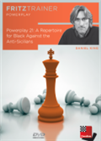 Accept the Morra Gambit with confidence. Tame the Grand Prix Attack. Put fear into the heart of every tedious 2 c3 player. You can make 1...c5 a dangerous weapon whether it's an open or closed Sicilian.
Accept the Morra Gambit with confidence. Tame the Grand Prix Attack. Put fear into the heart of every tedious 2 c3 player. You can make 1...c5 a dangerous weapon whether it's an open or closed Sicilian.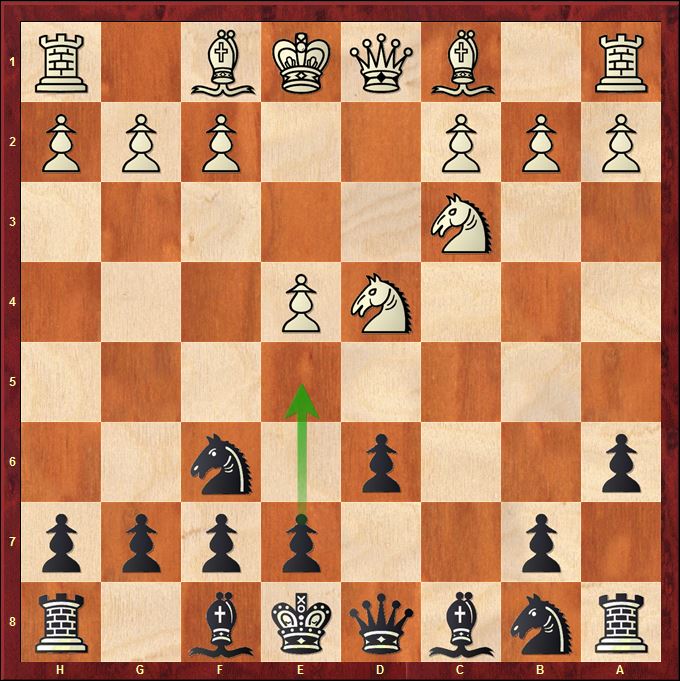
This is a very important piece of information, because Black is not obliged to play such move, as many of Kasparov's games prove.
While selecting Kasparov's games I noticed he passed from the Najdorf to the hedgehog, and this kind of pawn formation was treated by Pelletier in another series. Why I mention it? Because knowledge is definitely power, and I prefer to give the choice to the reader, for the direction he could develop his opening repertoire.
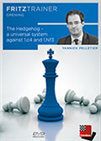 At first glance, the Hedgehog setup might appear somewhat passive but in fact Black is always waiting to launch a counterattack. Let Yannick Pelletier provide you with a complete repertoire against the English and the Reti!
At first glance, the Hedgehog setup might appear somewhat passive but in fact Black is always waiting to launch a counterattack. Let Yannick Pelletier provide you with a complete repertoire against the English and the Reti!Pelletier immediately adds one that doesn't have the choice of e7-e5 if White plays ♗g5 or ♗c4, and in those cases e6 is the correct answer.

What's on the FritzTrainer?
So how is this video series structured? Pelletier begins by showing twelve thematic games played by great classical and modern players. The goal of this instructive method is to give the viewer the main plans and ideas behind the moves, so if one doesn't like to follow boring theoretical videos, he can begin to play the Najdorf using the brain, instead of memorization.
Pelletier is honest, saying he has chosen a dozen games mostly won by Black, but in real life this doesn't happen. These videos are followed by nine videos on theory. Pelletier grabs the bull by the horns, and delves into specific lines. Obviously each video is dedicated to the main moves White can play on move 6, with the last video which deals with sidelines and rare moves. All this is followed by the interactive testing part, with small video clips in which Pelletier asks questions about the positions he presents. The videos running time is about seven hours. Of course one would be quite mistaken in thinking Pelletier covered everything possible in seven hours. But thanks to the games' database the serious student can fill any the gaps in preparation.
The database is made up of 256 thematic games one must watch and learn by heart! A light joke, but there is some truth in it. If one really wants to understand how different masters treat the various lines of the Najdorf, and the different plans they have against each line, clearly this is the way to go. One must watch the games and try to keep them in mind in order to know what to do. This will also help in two different ways. One is anxiety. I hear most of my students comment about the anxiety of going to a tournament, I believe such anxiety is generated by a lack of preparation. When one is prepared, he will also know how to treat different types of structures and ideas White can throw into the game, and how to deal with them. The second way it helps is related to time-trouble. Again we don't need to re-invent the wheel every time, we can use the ideas of other great players. So to avoid time-trouble one should watch all these games, to see which ideas will be able to use in one's own games.
I've mentioned it in other reviews, but I believe it's important to acknowledge the work made by the ChessBase team in order to give us products which are aimed at improving our chess. The new DVDs all come out with a "Repertoire Training" which one can see the explanation in the snippet:
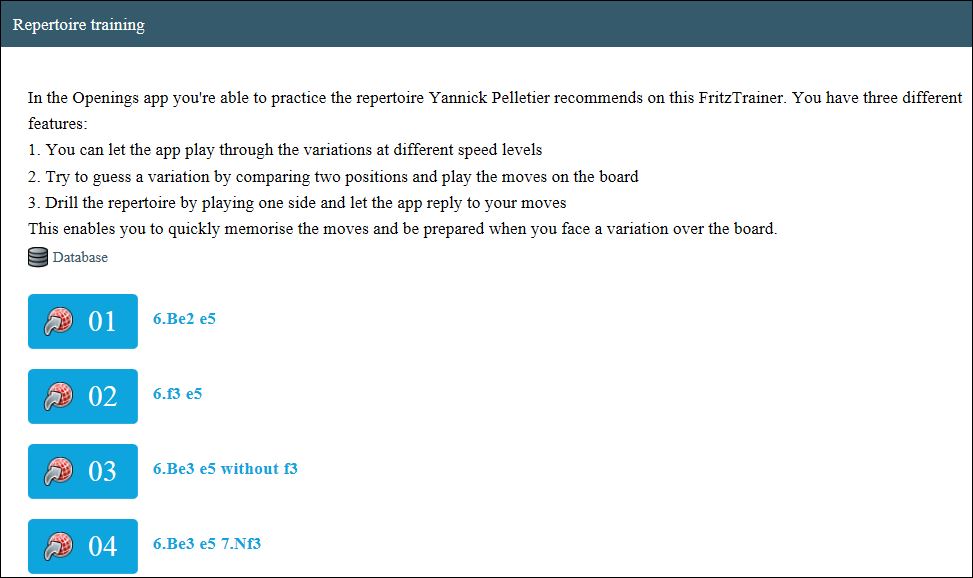
And a "practice positions":
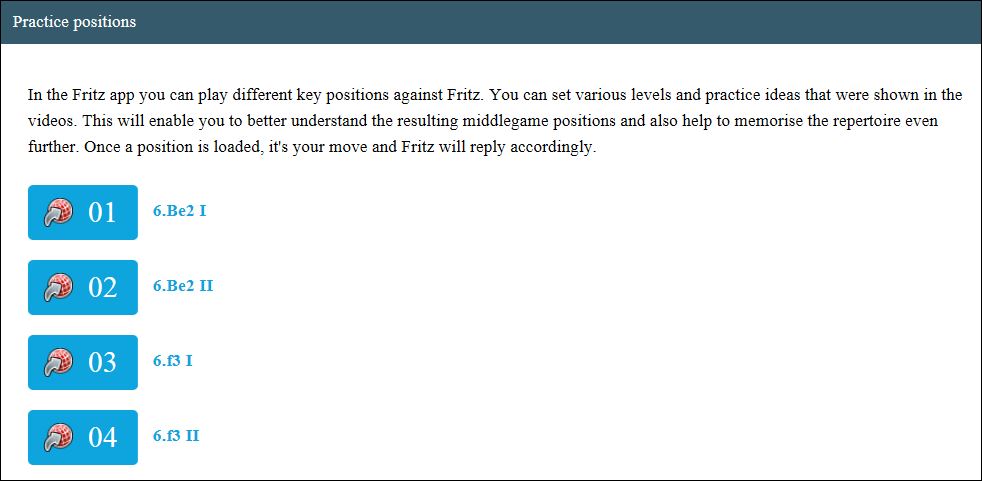
The last part is made up of a "Bonus" section where one can find the games database, described previously, the "Analysis" section with the annotated games from the twelve thematic videos, plus the annotated theoretical section. To study it all will surely take several months, if not years!
What's in a name?
In the beginning of the FritzTrainer Pelletier makes a puzzling statement. He says: "the reason they gave the name Najdorf to this variation of the Sicilian is unclear to me, because he has not invented the line..." and then Pelletier continues to explain there were greater champions who adopted the Najdorf as main weapon, and of course the names of Bobby Fischer and Kasparov are the one Pelletier considers as players who should have been awarded the naming of such variant of the Sicilian.
Let's begin to see when was the first game played in the Najdorf: 1. e4 c5 2. ♘f3 d6 3. d4 cxd4 4. ♘xd4 ♞f6 5. ♘c3 a6:
In fact the first game we have in the database is from 1926, Yates vs Tartakower, and Black loses badly.
The ChessBase Mega Database 2020 is the premiere chess database with over eight million games from 1560 to 2019 in high quality. Packing more than 85,000 annotated games, Mega 2020 contains the world‘s largest collection of high-class analysed games. Train like a pro! Prepare for your opponents with ChessBase and the Mega Database 2020. Let grandmasters explain how to best handle your favorite variations, improve your repertoire and much more.
Do we have other important chess names, who have played the Najdorf before Najdorf? Of course — Canal, Fine, Ragozin, Noteboom, just to mention few. Najdorf began to play it (according to Megabase 2020) in 1939 at the Olympiad in Buenos Aires, when after the beginning of World War II a lot of chess players would decide, wisely, to stay in Argentina, and don't return to Europe. Here's the game:
This game was played on September 18th, World War II began on September 1st. It's possible that the quality of the games (and this specific game) was low, because the players were more anxious to know what would happen to their families and countries, and that surely made difficult focusing on chess.
The names of Kotov, and Opocensky also appear many times in the usage of the Najdorf between 1940 and 1946.
Then the name of Najdorf for this particular variant reappears in a tournament in 1947 at Mar del Plata, and then in a radio match in 1948, which makes me think that Najdorf (maybe with the help of other Argentinean players like Pilnik, Rossetto, or Panno) was investigating this line, and preparing it for use in bigger future events, like the Chess Olympiad played in 1950 and 1952 or one of the most famous interzonal: Zurich 1953.
Here the games just above mentioned:
At the Olympiads in Dubrovnik (Najdorf had best result as first board) and Helsinki Najdorf and Argentina (the team got 2nd in Helsinki behind the Soviet Union!) had really good results, the opening's fame rose, which could be a possible explanation over the naming of the line.
For sure we can say this line of the Sicilian was not named because of Najdorf's successful results against legendary players or world champions. I've taken a small sample to show the dangers Black can run into. The game against Fine is interesting because we witness the power of the bishop pair, while the game against Smyslov teaches the hard lesson that not all opposite color bishop endgames are drawn (ChessBase has a set of great tools, if as reader you don't find yourself comfortable to win the endgame in Smyslov vs Najdorf, try to play it against the engine and practice).
The game against Geller is annotated in the book: "The Application of Chess Theory" (game 14 page 31) by Cadogan, which I bought last Sunday for 5$ at the Chess Club! The Keres game is definitely a reminder that every sword is double-edged, and this type of Sicilian can be quite dangerous for Black. Definitely a masterpiece by Keres!
And let's finish this small sample of games played by Najdorf as Black, with one played against the Legend, he was 19 at the time, but we can see he is in a class of his own:
Now while searching for an answer to Pelletier's question, I found in the book by Daniel King on the Najdorf a passage which could throw some light. In the introduction GM King writes:
But as Najdorf himself freely admits, he was not the inventor of the system. As is so often the case, it is not the originator of an idea who gets the credit, but the one who sees its merit and is able to apply it successfully — Najdorf was strong enough to do that.
King then goes on to credit the player Opocensky as the one. And show a game by Opocensky played in 1943 as first game, but in the time the book was written (1993) King couldn't access the resources we have today. I'm lucky to use Megabase 2020, and the first game played by Opocensky (surely one day someone will point out there are others prior to these two) is from 1942, I put the one mentioned by King and mine to show the power of Megabase 2020 which with few clicks allow us to find material difficult to find in previous chess periods. One should have had many books, and lose hours to find the information looked for.
To avoid misrepresenting King, the point he made surely is not who played the first game, but if there was a group of players who studied such opening, and came out with new ideas others missed previously. To this King gave the name of Opocensky. While investigating, I discovered the Soviet players were quite good with White, showing they had done their homework. Maybe today we should think of different group of players, from different nations doing their analysis on the Najdorf. But Opocensky for me is good enough, also if I'm sure a chess historian could teach us more on the evolution of the ideas in the "Najdorf" and who are the biological parents. Thanks to Pelletier's questioning I had the chance to educate myself, and challenge my belief Najdorf was the creator of this variant of the Sicilian. Through this research I've seen the many dangers Black can fall into, and the common themes Black players had to face.
Pelletier has done a good job also in showing different pawn structures, and the ideas/plans behind, which are tailored to the pawn structure. This can give the beginner a general and clear idea, while the most advanced player should already have some ideas.
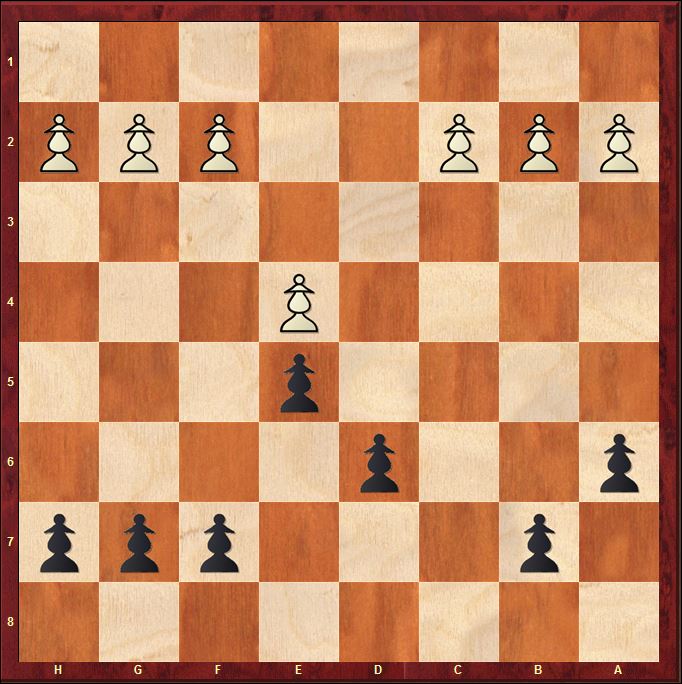
For example a more advanced player would begin noticing how this pawn structure is similar to other lines in the Sicilian, the e5 pawn makes the Sicilian Sveshnikov come to mind, and immediately recognize the plans and ideas studied in those other Sicilians. Pelletier explains simple ideas like backward pawn, semi-open files, etc. which make the FritzTrainer very good for beginners, and intermediate players.
Final Thoughts
The Sicilian is an opening everyone should try to play. The themes, and ideas one can find inside will form the backbone of every chess player. Especially the understanding of the fight for important squares, which pieces to exchange, and of course the eternal fight for the center. The Sicilian is rich in tactics, and it's definitely the opening to study if one wants to learn how to attack on both sides, especially against the castled king. However, the most important lesson is "patience". Yes, nobody learned the Sicilian Najdorf in one day; one will need hours of study for the videos, and hours of study for the games (I suspect reviewing all the games selected for this series could take two months), and then of course many hours to practice, and see what was missed, or forgotten. All this work will certainly bring the serious chess player to the next level.
Links
.jpeg)






















